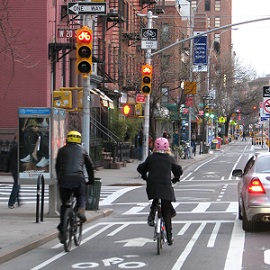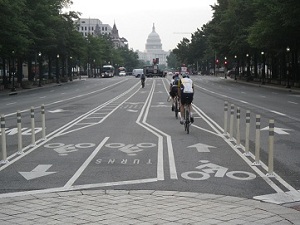
IN THIS ISSUE:
Dedicated Paths and Lanes: Their Influence on Bike Commuting
Grantee Spotlight: Honolulu’s Transit-Oriented Housing Strategy
Study Confirms Energy Savings in Multifamily Building Retrofits
Mixed-Use, Transit-Oriented Development in Arlington, Virginia
Dedicated Paths and Lanes: Their Influence on Bike Commuting

Image courtesy of Kyle Gradinger/BCGP. In recent years, cities across the country have addressed the need for cycling infrastructure in various ways. Some cities, such as New York and Chicago, have added on-street bike lanes. Others have added cycling paths or off-street multimodal trails that cyclists share with pedestrians, runners, and in-line skaters.
A recent study published in the journal Transportation examined bike commuting in 90 of the largest American cities and the influence that bike paths and lanes have on commuter cycling rates. The study, conducted by Ralph Buehler of Virginia Polytechnic Institute and State University and John Pucher of Rutgers University, found that cities with more bike paths and lanes have significantly higher rates of bike commuting, even when factors that influence cycling rates – such as weather, cycling safety, degree of sprawl, and the price of gasoline – are taken into account. This study assesses bike lanes and paths separately to determine how the different types of cycling infrastructure influence commuter cycling behavior.
Data Analysis
Buehler and Pucher used 2008 city-level data, collected by the League of American Bicyclists and the Alliance for Biking and Walking, that describe the availability of bike lanes and paths. To analyze variation in bike commuting across cities, the study used data from the 2006–2008 American Community Survey (ACS) on commuting behavior.
Although ACS data show that, on average, less than one percent of the population cycles to work, Buehler says that the actual number of bike commuters may be higher. The ACS asked people to report only their primary mode of transportation (even if they used more than one). As a result, the data likely does not capture part-time biking activity of people who bike to work once or twice a week but drive or take public transportation the rest of the time. The ACS survey question also does not capture data on seasonal bike commuters or commuters who cycle to or from public transportation. Finally, Buehler points out, the ACS does not measure non-commuting bike trips, such as errands or doctor appointments. As these types of trips are not captured in the ACS data, the study was limited to the influence of bike lanes and paths on bike commuting.
Elements That Influence Bike Commuting

Cyclists ride in the dedicated Pennsylvania Avenue Cycletrack in Washington, DC
Nevertheless, the study found that cities with more bike paths and lanes, on-street lanes, and off-street paths have higher rates of bike commuters. Other findings included:
- Of the 90 U.S. cities included in the study, Portland, Madison, Minneapolis, Boise, and Seattle had the highest percentages of bike commuters.
- Higher shares of college students in an area’s overall population, as well as increases in gas prices, are associated with higher bike commuting levels, whereas higher cyclist fatality rates are associated with lower rates of bike commuters.
- Higher sprawl ratings and higher levels of car ownership are associated with lower cycling rates.
Buehler notes that bike paths and lanes affect different kinds of cyclists. For instance, he says, younger, male cyclists are more likely to cycle in on-street bike lanes, while older and female riders are more likely to cycle in off-street bike paths. Either way, says Buehler, "[b]uilding bicycle networks is positively connected to cycling levels."
